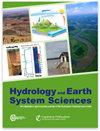三维的不确定性:传达概率洪水预报图的挑战
IF 5.8
1区 地球科学
Q1 GEOSCIENCES, MULTIDISCIPLINARY
引用次数: 0
摘要
摘要实时操作洪水预报通常集中于发布沿流域河流的特定点的流量预测。然而,我们现在看到越来越多的研究旨在将绘制洪水地图作为预报系统的一部分。虽然这些额外的新信息(洪水范围、深度、速度等)可能对决策者有用,但它也可能是压倒性的。这对于概率预报和集合预报系统尤其如此。虽然空间中给定点的集合流预测可以相对容易地可视化,但对水深和范围的概率预测的可视化和通信构成了额外的挑战。混淆通常是由太多的信息,违反直觉的解释,或者仅仅是过于复杂的预测表示引起的。概率流量预报的通信和可视化已经在过去进行了研究,但概率洪水预报图还没有这样做,它仍然是一个新兴的产品。在本文中,我们综合了一项大规模调查的结果(28名政府代表,52个市政当局,9个组织,38名公民和农民,总共140人),关于用户在整个河流流域的可视化概率洪水预测方面的偏好。调查通过访谈的方式进行,在访谈中,受访者被问及他们在水文预报方面的需求。我们还向受访者展示了四个原型,代表相同概率预测的不同可视化,以便了解他们在颜色地图、措辞和不确定性表示方面的偏好。我们的研究结果强调了在可视化预测洪水地图的特定背景下与理解概率相关的几个问题。我们提出了一些可视化概率洪水图的建议,并描述了针对不同类别最终用户的潜在适应。这项研究首次对概率洪水地图的可视化进行了研究,这一技术越来越受欢迎。鉴于访谈问题与特定地理位置无关,我们的研究结果适用于研究区域之外,因此也适用于其他有兴趣为决策组织和公民提供概率洪水预报地图的业务中心。本文章由计算机程序翻译,如有差异,请以英文原文为准。
Uncertainty in three dimensions: the challenges of communicating probabilistic flood forecast maps
Abstract. Real-time operational flood forecasting most often concentrates on issuing streamflow predictions at specific points along the rivers of a watershed. However, we are now witnessing an increasing number of studies aimed at also including flood mapping as part of the forecasting system. While this additional new information (flood extent, depth, velocity, etc.) can potentially be useful for decision-makers, it could also be overwhelming. This is especially true for probabilistic and ensemble forecasting systems. While ensemble streamflow forecasts for a given point in space can be visualized relatively easily, the visualization and communication of probabilistic forecasts for water depth and extent pose additional challenges. Confusion typically arises from too much information, counterintuitive interpretation, or simply too much complexity in the representation of the forecast. The communication and visualization of probabilistic streamflow forecasts has been studied in the past, but this is not the case for the probabilistic flood forecast map, which is still an emerging product. In this paper, we synthesize the results of a large-scale survey (28 government representatives, 52 municipalities, 9 organizations, and 38 citizens and farmers, for a total of 140 people) regarding the users' preferences in terms of visualizing probabilistic flood forecasts over an entire river reach. The survey was performed through interviews, during which the interviewees were asked about their needs in terms of hydrological forecasting. We also presented the interviewees with four prototypes representing alternative visualizations of the same probabilistic forecast in order to understand their preferences in terms of colour maps, wording, and the representation of uncertainty. Our results highlight several issues related to the understanding of probabilities in the specific context of visualizing forecasted flood maps. We propose several suggestions for visualizing probabilistic flood maps and also describe potential adaptations for different categories of end users. This study is the first to investigate the visualization of probabilistic flood maps, which are gaining popularity. Given that the interview questions were not tied to a specific geographical location, our findings are applicable outside of the study area and, therefore, to other operational centres interested in providing probabilistic flood forecast maps to decision-making organizations and citizens.
求助全文
通过发布文献求助,成功后即可免费获取论文全文。
去求助
来源期刊

Hydrology and Earth System Sciences
地学-地球科学综合
CiteScore
10.10
自引率
7.90%
发文量
273
审稿时长
15 months
期刊介绍:
Hydrology and Earth System Sciences (HESS) is a not-for-profit international two-stage open-access journal for the publication of original research in hydrology. HESS encourages and supports fundamental and applied research that advances the understanding of hydrological systems, their role in providing water for ecosystems and society, and the role of the water cycle in the functioning of the Earth system. A multi-disciplinary approach is encouraged that broadens the hydrological perspective and the advancement of hydrological science through integration with other cognate sciences and cross-fertilization across disciplinary boundaries.
 求助内容:
求助内容: 应助结果提醒方式:
应助结果提醒方式:


